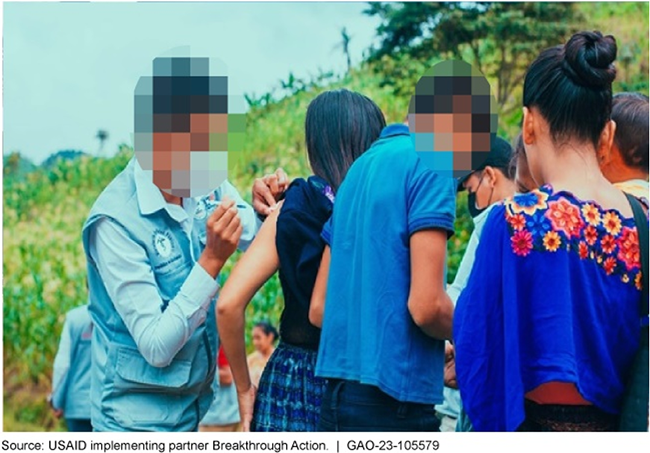COVID-19: USAID Plans to Share Lessons Learned from Efforts to Meet Global Vaccination Goal
Fast Facts
Millions of people around the world have died from COVID-19. The U.S. government has pledged to help reach a goal to vaccinate 70% of the global population against the virus.
In support of this goal, the U.S. Agency for International Development worked with global and local partners to help 125 countries vaccinate their populations against COVID-19. But issues like falling demand for the vaccine and difficulty reaching remote areas have affected this work. As a result, almost two-thirds of these countries had vaccination rates below 50%.
USAID plans to share lessons learned from these issues to help its partners prepare for future pandemics.
USAID supported COVID-19 vaccinations in indigenous communities in Guatemala

Highlights
What GAO Found
The U.S. Agency for International Development (USAID) supports COVID-19 vaccine country readiness and delivery abroad by assisting a country's capacity to receive and administer vaccines. As of March 2023, USAID obligated an estimated $904 million to support its COVID-19 country readiness and delivery efforts in 125 countries. USAID's obligations for these efforts covered eight areas of technical assistance, including promoting demand for vaccination and supporting supply chain logistics.
USAID, together with other U.S. agencies, host governments and other entities, helped vaccinate an average of 45 percent of the population across assisted countries as of July 2023. This average was in comparison to the global goal of 70 percent vaccination in each country. Close to two-thirds of the assisted countries had vaccination rates below 50 percent, and most of those rates have leveled off. Regional vaccination rates for countries that received USAID assistance ranged from an average of 28 to 63 percent (see figure). USAID stated that it could not measure its direct contribution to countries' vaccination progress because, among other things, the agency is only one of many entities involved in these efforts.
Average Fully Vaccinated Rate by Region for Countries Assisted by the U.S. Agency for International Development (USAID) as of July 5, 2023

Note: Vaccination rates reflect the efforts of USAID and other entities in assisted countries. USAID officials, citing World Health Organization guidance, defined “fully vaccinated” as a complete primary series, which may be one or two doses depending on the vaccine manufacturer. USAID assisted 125 countries; no vaccination data existed for two small USAID-assisted countries in Asia. The most recent vaccination rate data for most countries are prior to July 2023.
USAID faced demand, supply, and other challenges in providing COVID-19 vaccine country readiness and delivery assistance. U.S. agency officials in assisted countries reported that demand issues have overtaken supply issues as the greatest challenge to these efforts. Demand issues included, for example, vaccine hesitancy and barriers associated with people getting to vaccine sites. As vaccine demand diminished, USAID and other partners shifted priorities to vaccinating vulnerable groups and incorporating activities into countries' primary healthcare systems on the way to reaching the global 70 percent vaccination goal. USAID initiated several efforts to learn from these challenges, and has plans to disseminate the lessons learned, in accordance with agency guidance.
Why GAO Did This Study
To attain high population immunity from COVID-19 during the pandemic, the U.S. pledged to substantially contribute toward a 70 percent vaccination goal of the world's population, initially by the end of 2022. USAID has partnered with other U.S. agencies, multilateral organizations, and donor countries on country readiness and delivery efforts to significantly increase assistance to countries around the world to meet the vaccination goal.
The CARES Act includes a provision for GAO to monitor the federal government's response to the COVID-19 pandemic. This report examines (1) the assistance USAID has provided to support COVID-19 vaccine country readiness and delivery abroad, (2) progress USAID has made in its efforts to support COVID-19 vaccine country readiness and delivery abroad, and (3) any challenges USAID has faced and how it has addressed them.
GAO reviewed laws, funding, and guidance documents from USAID, the Department of State, the Centers for Disease Control and Prevention, and the World Health Organization. GAO analyzed publicly available data to obtain global vaccination rates. GAO also interviewed USAID officials in Washington, D.C., and USAID officials and other local stakeholders in three countries: Guatemala, Malawi, and South Africa. GAO selected these countries based on factors such as the amount of estimated country readiness and delivery assistance USAID obligated for each country.
For more information, contact Latesha Love-Grayer at (202) 512-4409 or LoveGrayerL@gao.gov.
